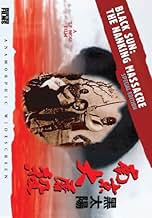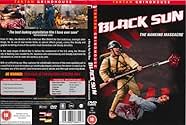Adicionar um enredo no seu idiomaIn 1937, Japanese troops raid the Chinese city of Nanking to execute a planned massacre by subjecting over 300,000 helpless civilians to various tortures and atrocities before slaughtering t... Ler tudoIn 1937, Japanese troops raid the Chinese city of Nanking to execute a planned massacre by subjecting over 300,000 helpless civilians to various tortures and atrocities before slaughtering them all.In 1937, Japanese troops raid the Chinese city of Nanking to execute a planned massacre by subjecting over 300,000 helpless civilians to various tortures and atrocities before slaughtering them all.
- Direção
- Roteirista
- Artistas
Avaliações em destaque
I really don't know what to think of this movie. I would say that, after the first 30 minutes I was ready to dismiss it. I don't think it's inability to pick a genre is a virtue (though I think it could have been). I also think the film comes off way too much like a propaganda film for the People's Republic. It seems to suggest that the "Rape of Nanking" was some kind of secret. Well, for whatever reason, I knew about it already, and so I thought that attitude was rather odd. Another random thing: that introduction is bizarre. There must have been 30-40 cuts in 90 seconds. That's just insane. It didn't work in my mind. But anyway, the director has more balls than any American or even just any mainstream filmmaker would in depicting the atrocities. Though an atrocity doesn't automatically make a good film, I still find this attempt at truly conveying the horror commendable. And further, there is no imposed happy ending, unlike western films that try to deal with these things. For that, I think I can forgive the stylistic difficulties.
THE NANKING MASSACRE is another solid piece of work from T.F. Mou regarding the atrocities that the Japanese brought upon the Chinese in WWII. Personally, I felt that this installment lacked the punch of MEN BEHIND THE SUN, but was still very effective in trying to relate the horrors of war and oppression. There are a few "gore" scenes, but to be quite honest, they almost come off a little comically (or i'm just sick...). I found the "forced abortion" and the "baby in the rice steamer" scenes to be pretty hilarious, though I'm sure they weren't meant to be - the FX just looked silly and not horrifying. That's not to make light of the film itself or of what actually happened in China at that time period. All-in-all I found the film to be very moving, and should really be looked at as a history lesson more than as a horror film. I know that "extreme" horror fans will seek this and MEN BEHIND THE SUN out for their notorious reputations as "shocking" and "horrific" gore films, but I think that those who are just looking for blood-and-guts will be severely disappointed. As I stated before, these are neither horror nor gore films, but a fictionalized recreation of events. Either way, I feel that they are both good films, although I prefer MEN BEHIND THE SUN over THE NANKING MASSACRE. Definitely not for everyone due to some graphic material, but highly recommended 7 1/2 out of 10
It's not often you hear about the Japanese atrocities committed against the Chinese. Black Sun : The Nanking Massacre unflinchingly tells the true story of the over 300,000(that's 300,000!!!!) Chinese people who were brutally killed by the occupying Japanese army. Mixed with real film footage and photographs of the actual events, the film really shows the atrocities of war. It's mostly told from the Japanese point of view, and several conversations between Japanese commanders and soldiers are chilling. There are some exploitative gross out moments, like an unborn baby being pulled out of a pregnant woman's stomach via bayonette...but it always feels true. There are so many scenes of crowds being machine gunned down that you can be desensitized pretty early on in the film. The scary thing is, is the Japanese really WERE this barbaric. They slaughtered babies, infants, children, women, men and monks alike. The scene of hundreds of bodies being burned on the beach is a truly haunting moment. While it is an absolute must see for war film fans or historians...the film, however, is gory enough to make splatter fans happy.
This is worth viewing and the DVD Special edition well worth buying for the 'extras', but there are one or two problems. I think the main difficulty is that the director has available to him awful, original footage of events and decides to mix these in with what for the main part can only be described as exploitative material. Nothing wrong with a good old exploitation movie of course but here the, probably cheaply done, massed bodies and brutal slayings look nothing compared to the original sickening footage. There are moments like the burning of the bodies at the river's edge that are undoubtedly powerful but for the most part we are only too aware that this is a one event movie spun out for the sole reason of showing the spilling of blood and guts and getting across the message that the Japanese are evil. Having said all that the DVD distributors have exceeded themselves and included notable items including a most illuminating 1944 US propaganda film, 'Why We Fight: The Battle Of China' - not to be missed.
Gripping and sadistic movie that happens when China is invaded by Japan on the onset of war and finds Japanese army surrounding and butchering people at city of Nanjing (1937). After that , at the city violations , mutilaciones and massacres take place . Prisoners and other unfortunate people are interred in camp prisons, but then they are led to fire squad , scaffold or alive burying .
Director deglamorizes war showing true horror and ominous, bloody deeds , but in exploitation style , at times . It's a staggering evocation of the Chinese holocaust in Nanjing , as the atrocities are depicted as a disturbing matter and as an astonishing factor by-product of sheer Japanese evil . There are graphic depiction of the horrible massacres with lots of blood , gore and guts . Packing some really disagreeable and shocking images , no apt for squeamish. It describes the terrifying Japanese encroachment in which the military will stop at nothing to wipe out the Nanjing population and at whatever cost with all kinds of execution means . However , this gory picture relies heavily on sadistic and ultra-violent scenes, including beheading , murders in cold blood , mutilation, dismemberment , slashing and anything else .
The picture is set in 1937 Nanking and based on true events. After Nanking was occupied by the Japanese Army, massive burning , rape, killing and plundering continued for six weeks. Males, females and young, none were spared. The atrocities were even worst thah shown in this film. This was not a War. It was an intentional, planned and organized massacre. During the Nanking massacre... 43.123 bodies collected by the Buddhist Society, 22.683 collected by the Red Cross, 112.267 collected by Chun Shan Society, 7.000 collected by Tung Shan Society, 28.000 collected by Shen Chang and others, 7.000 bodies collected by Ruy Fang and others, 3000 bodies collected by Kao Guan and others, 90.000 bodies handled by the Japanese. According to the verdict of the war crimes tribunal in 1947 the Japanese Army was judged to have raped over 20000 women and killed 300.000 Chinese during the Nanking Massacre. One-third of the city was destroyed. Property was plundered at unestimated losses. No family was spared. Main responsible officers were judged. Matsui Iwane was sentenced by the Far East International War Crimes on Nov 12, 1947 and subsequently hanged. Tani Hisao sentenced by The Chinese War Tribunal in 1947 and executed. Mukai Tosjiaki, Noda Iwa, Tanaka Gunkichi sentenced by the Chinese War Tribunal and executed in 1948 . Nakajima Kyogo died of natural causes in 1945.
Director deglamorizes war showing true horror and ominous, bloody deeds , but in exploitation style , at times . It's a staggering evocation of the Chinese holocaust in Nanjing , as the atrocities are depicted as a disturbing matter and as an astonishing factor by-product of sheer Japanese evil . There are graphic depiction of the horrible massacres with lots of blood , gore and guts . Packing some really disagreeable and shocking images , no apt for squeamish. It describes the terrifying Japanese encroachment in which the military will stop at nothing to wipe out the Nanjing population and at whatever cost with all kinds of execution means . However , this gory picture relies heavily on sadistic and ultra-violent scenes, including beheading , murders in cold blood , mutilation, dismemberment , slashing and anything else .
The picture is set in 1937 Nanking and based on true events. After Nanking was occupied by the Japanese Army, massive burning , rape, killing and plundering continued for six weeks. Males, females and young, none were spared. The atrocities were even worst thah shown in this film. This was not a War. It was an intentional, planned and organized massacre. During the Nanking massacre... 43.123 bodies collected by the Buddhist Society, 22.683 collected by the Red Cross, 112.267 collected by Chun Shan Society, 7.000 collected by Tung Shan Society, 28.000 collected by Shen Chang and others, 7.000 bodies collected by Ruy Fang and others, 3000 bodies collected by Kao Guan and others, 90.000 bodies handled by the Japanese. According to the verdict of the war crimes tribunal in 1947 the Japanese Army was judged to have raped over 20000 women and killed 300.000 Chinese during the Nanking Massacre. One-third of the city was destroyed. Property was plundered at unestimated losses. No family was spared. Main responsible officers were judged. Matsui Iwane was sentenced by the Far East International War Crimes on Nov 12, 1947 and subsequently hanged. Tani Hisao sentenced by The Chinese War Tribunal in 1947 and executed. Mukai Tosjiaki, Noda Iwa, Tanaka Gunkichi sentenced by the Chinese War Tribunal and executed in 1948 . Nakajima Kyogo died of natural causes in 1945.
Você sabia?
- CuriosidadesThis film's closing epilogue states: "After Nanking was occupied by the Japanese Army, massive burning, killing, raping and plundering continued for 6 weeks. Males, females, old, and young - none were spared. The atrocities were even worst than that shown in this film. This was not a war. It was an intentional, planned, and organized massacre."
- ConexõesFollows Campo 731 - Bactérias, a Maldade Humana (1988)
Principais escolhas
Faça login para avaliar e ver a lista de recomendações personalizadas
Detalhes
Contribua para esta página
Sugerir uma alteração ou adicionar conteúdo ausente

Principal brecha
By what name was Hei tai yang: Nan Jing da tu sha (1995) officially released in Canada in English?
Responda



















